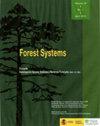大西洋雨林遗迹中的垃圾分解与竹子的优势
IF 0.7
4区 农林科学
Q3 FORESTRY
引用次数: 0
摘要
研究目的:我们比较了林下以竹子为主的区域和没有这种优势的区域之间累积的枯枝落叶的分解率、蓄积量和养分向土壤的返回。研究区域:Fontes do Ipiranga州立公园,巴西东南部圣保罗市大西洋森林的城市碎片。材料和方法:在一年(0、3、6、9和12个月)内测量分解率,避免通过尼龙网在土壤上添加垃圾。收集的材料被分离成以下部分:竹叶和树枝(竹材料);其他树叶和树枝(其他材料);无法识别(无法识别)的非常分解的物质。测定了常量(N、P、K、Ca、Mg和S)和微量营养素(B、Cu、Fe、Mn和Zn)的含量。主要结果:成熟区的枯枝落叶量明显高于竹区。两个区域的分解率没有显著差异。除K和Mn外,成熟林中常量和微量营养素的浓度等于或大于。研究重点:与其他地区的报道不同,竹子为主的下层林中没有更多的枯枝落叶堆积,分解速度也较慢。竹类干扰区养分含量较低。本文章由计算机程序翻译,如有差异,请以英文原文为准。
Litter decomposition in a remnant of Atlantic Rain Forest and bamboo dominance
Aim of study: We compared the decomposition rate of the accumulated litter, the stock, and the return of nutrients to the soil, between an area dominated by bamboos in the understory and an area where this dominance does not occur.
Area of study: Fontes do Ipiranga State Park, an Urban Fragment of Atlantic Forest at the Municipality of São Paulo, Southeastern Brazil.
Materials and methods: The decomposition rates were measured over one year (0, 3, 6, 9, and 12 months), avoiding litter addition through nylon nets over the soil. The collected material was separated into the following fractions: bamboo leaves and branches (bamboo material); other leaves and branches (other material); very decomposed material not identifiable (unidentifiable). The content of macro (N, P, K, Ca, Mg, and S) and micronutrients (B, Cu, Fe, Mn, and Zn) were determined.
Main results: The litter accumulated was significantly higher in the mature area than in the bamboo area. The decomposition rates did not differ significantly between the two areas. Except for K and Mn, the concentrations of macro and micronutrients were equal to or greater in the mature forest.
Research highlights: Unlike reported in other areas, there is no greater litter accumulation in the bamboo-dominated understory nor a slower decomposition rate. The nutrient content is lower in the bamboo-dominated disturbed area.
求助全文
通过发布文献求助,成功后即可免费获取论文全文。
去求助
来源期刊

Forest Systems
FORESTRY-
CiteScore
1.40
自引率
14.30%
发文量
30
审稿时长
6-12 weeks
期刊介绍:
Forest Systems is an international peer-reviewed journal. The main aim of Forest Systems is to integrate multidisciplinary research with forest management in complex systems with different social and ecological background
 求助内容:
求助内容: 应助结果提醒方式:
应助结果提醒方式:


